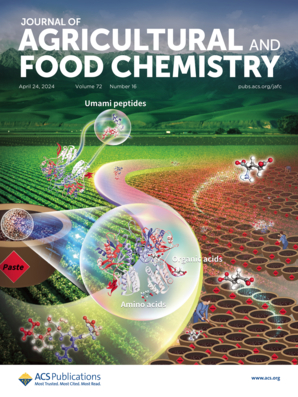高效合成乳酸- n -新四糖的无质粒工程大肠杆菌的构建与系统优化。
IF 5.7
1区 农林科学
Q1 AGRICULTURE, MULTIDISCIPLINARY
引用次数: 0
摘要
乳酸-n -新四糖(LNnT)是一种重要的母乳低聚糖(HMO),具有重要的益生元功能,支持有益肠道微生物群的生长,有助于婴儿健康。通过代谢工程构建无质粒菌株用于LNnT生物合成是一种高效工业规模生产的可行策略。本研究整合了多种策略来构建能够高效生产LNnT的无质粒菌株。以先前开发的生产乳酸- n -三糖II (LNTri II)的大肠杆菌MG1655菌株为基础,引入编码β1,4-半乳糖基转移酶的Hplex2B,并优化其拷贝数,构建完整高效的生物合成途径。通过整合多药外排泵基因mdfA的额外拷贝,提高了菌株的耐受性,从而提高了LNnT的产量。将不同启动子强度的糖基供体合成途径中关键基因(包括glmS、glmM、glmU、galU和galE)的表达盒整合在一起,优化了供应和平衡。随后去除一个关键的反馈抑制回路,将反应导向LNnT的合成。经过连续优化,最终菌株摇瓶培养LNnT产量为7.76 g/L, 5 L生物反应器培养LNnT产量为34.24 g/L, LNTri II前体浓度分别为0.58 g/L和1.61 g/L。本文章由计算机程序翻译,如有差异,请以英文原文为准。
Construction and Systematic Optimization of Plasmid-free Engineered Escherichia coli for Efficient Lacto-N-Neotetraose Biosynthesis.
Lacto-N-neotetraose (LNnT) is a key human milk oligosaccharide (HMO) with important prebiotic functions, supporting the growth of beneficial gut microbiota and contributing to infant health. Constructing plasmid-free strains via metabolic engineering for LNnT biosynthesis represents a feasible strategy for efficient industrial-scale production. This study integrates various strategies to construct plasmid-free strains capable of efficiently producing LNnT. Building on the previously developed Escherichia coli MG1655 strain for lacto-N-triose II (LNTri II) production, Hplex2B (encoding β1,4-galactosyltransferase) was incorporated, and its copy number was optimized to construct a complete and efficient biosynthetic pathway. By integrating an extra copy of the multidrug efflux pump gene mdfA, the strain tolerance was improved, resulting in a higher yield of LNnT. The integration of expression cassettes for key genes in the glycosyl donor synthesis pathway (including glmS, glmM, glmU, galU, and galE) with varying promoter strengths optimized the supply and balance. The subsequent removal of a key feedback inhibition circuit directed the reaction toward the synthesis of LNnT. The final strain, after successive optimization, produced LNnT at 7.76 g/L in shake flask culture and 34.24 g/L in a 5 L bioreactor, with precursor LNTri II concentrations of 0.58 g/L and 1.61 g/L, respectively.
求助全文
通过发布文献求助,成功后即可免费获取论文全文。
去求助
来源期刊
CiteScore
9.90
自引率
8.20%
发文量
1375
审稿时长
2.3 months
期刊介绍:
The Journal of Agricultural and Food Chemistry publishes high-quality, cutting edge original research representing complete studies and research advances dealing with the chemistry and biochemistry of agriculture and food. The Journal also encourages papers with chemistry and/or biochemistry as a major component combined with biological/sensory/nutritional/toxicological evaluation related to agriculture and/or food.

 求助内容:
求助内容: 应助结果提醒方式:
应助结果提醒方式:


